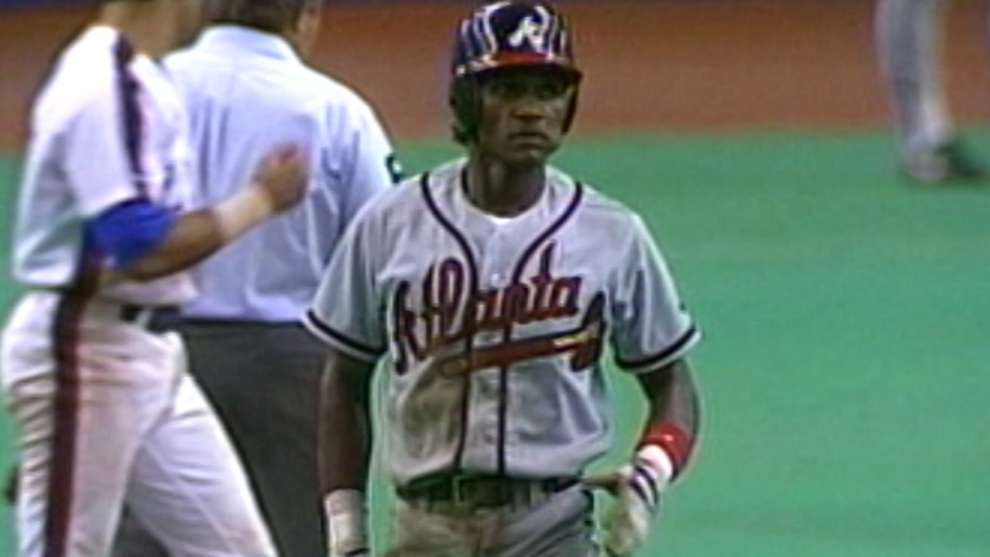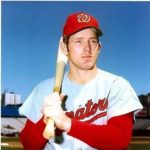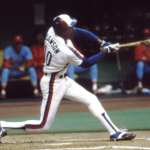Toby Harrah Stats & Facts
Toby Harrah
Positions: Third Baseman, Shortstop and Second Baseman
Bats: Right • Throws: Right
6-0, 175lb (183cm, 79kg)
Born: October 26, 1948 in Sissonville, WV us
High School: Elgin HS (Marion, OH)
Debut: September 5, 1969 (12,907th in major league history)
vs. BOS 0 AB, 0 H, 0 HR, 0 RBI, 0 SB
Last Game: October 4, 1986
vs. CAL 4 AB, 0 H, 0 HR, 0 RBI, 0 SB
Full Name: Colbert Dale Harrah
Pronunciation: \HAIR-ah\
View Player Info from the B-R Bullpen
View Player Bio from the SABR BioProject
Nine Other Players Who Debuted in 1969
Darrell Evans
Bill Buckner
Carlton Fisk
Steve Garvey
Bill Russell
Toby Harrah
Vida Blue
Jerry Reuss
Thurman Munson
All-Time Teammate Team
Coming Soon
Baseball is the only game you can watch on the radio. Join the community today and listen to hundreds of broadcasts from baseball’s golden age
Notable Events and Chronology
Biography
Harrah was a power-hitting infielder who spent most of his 17-year career on second-division teams. He was the Senators’ primary shortstop in their last season of existence and remained there for the franchise’s first five seasons in Texas. Coming up straight from Double-A ball in 1971, he was overmatched at first, hitting .230 and slugging .290. He improved as a batter and fielder in 1972 after spending the winter studying with Chico Carrasquel in South America. Harrah hit .259 with 10 HR despite missing time with an appendectomy and a shoulder injury; the injury forced him out of the All-Star Game.
He came into his own in 1974, hitting 21 HR with 74 RBI and 79 runs. It was the first of his five 20-HR seasons. He also showed range in the field, leading AL shortstops in putouts and tying in errors. Manager Billy Martin said, “I don’t know how a guy could cover more ground, and he also has that great arm.” In 1975 Harrah improved further, hitting .293 and drawing 98 walks while driving in a career-high 93 runs. It was the first of his .400 on-base percentage seasons; his .406 was fourth in the AL. TSN named him the shortstop on its postseason AL all-star team. In 1976 he had his best year defensively, leading AL shortstops in putouts and total chances per game (and errors). He also established the first of his two odd fielding records, accepting no chances at shortstop in a June 25 doubleheader. On September 17 the following year, he set another record by playing 17 innings at third base without recording an assist.
Harrah’s best year offensively came in 1977, when he was moved to third base after Bert Campaneris was signed as a free agent. Harrah led the AL with 109 walks and hit 27 HR, both career highs, and stole 27 bases. He and Bump Wills hit back-to-back inside-the-park home runs at Yankee Stadium. In 1978 he stole a career-high 31 bases but slumped to .229. He moved back to shortstop at mid-season as Campaneris hit .186.
After the season Harrah was traded to the Indians for Buddy Bell and he replaced Bell at third base. Although the Rangers often had losing records, they had contended in 1974, 1977, and 1978. In Cleveland, Harrah’s talents were buried on a perennial sixth-place finisher that dropped another notch when the expansion Blue Jays finally improved. In his five years with the Indians, Harrah scored 100 runs twice (his career high, in 1980 and 1982). In his only .300 season, .304 in 1982, he also hit 25 HR and finished second in the AL with a .400 on-base percentage. He led AL third basemen in fielding in 1983. At third, he almost always guarded the line, which cut down on his range; he maintained that it was more important to cut off potential doubles than singles. He played in 476 consecutive games before a Dennis Martinez pitch sidelined him with a broken hand in April 1983.
The Yankees acquired Harrah in a five-player deal in February 1984. By the end of spring training, Graig Nettles had been traded to San Diego for panning the club’s planned third-base platoon, and Harrah was not only faced with the pressure of replacing the popular Nettles, but was also blamed for causing his departure. He slumped horribly, lost the job to rookie Mike Pagliarulo, and hit just .217. After the season he was traded back to the Rangers for Billy Sample and a minor league pitcher. Happy to be back in Texas, he was the regular second baseman (Buddy Bell was at 3B) and rebounded to .270. Drawing a career-high 113 walks (second in the majors), he finished third in the AL with a .437 on-base average, behind Wade Boggs and George Brett. He retired after hitting .218 in 1986
In 1989, Harrah played for the West Palm Beach Tropics of the Senior Professional Baseball Association. He hit .318 in 63 games with the team.
After his playing days ended, Harrah managed the Oklahoma City 89ers in 1987 and 1988. He was a Rangers coach from 1989 to 1992, also managing the club for part of the season in his last year there. After a stint as skipper of the Norfolk Tides in 1995, he was later a member of the Indians staff in 1996 and was Colorado Rockies bench coach from 2000 to 2002.
Unusual feats:
Harrah was involved in three of the most unusual feats in Major League baseball history.
On June 25, 1976, he played an entire doubleheader without taking a single fielding chance. What was most unusual about this was that he managed to do so while playing shortstop, given the predominance of right-handed hitters in a baseball lineup (who will usually hit the ball to the left side of the infield).
Just over one year later, on August 27, 1977, Harrah and teammate Bump Wills would hit back-to-back inside-the-park home runs, the only time this feat has ever occurred in a Major League Baseball game.
On August 6, 1986, Harrah hit a second inning grand slam for the Rangers, while Baltimore Oriole players Larry Sheets and Jim Dwyer both went deep for grand slams in the Orioles’ nine-run fourth, establishing a new record for bases-full homers in one game (Texas beat Baltimore, 13-11).
In one American Legion Baseball game, he threw a no-hitter.
@ET-DC@eyJkeW5hbWljIjp0cnVlLCJjb250ZW50IjoicG9zdF90YWdzIiwic2V0dGluZ3MiOnsiYmVmb3JlIjoiTGVhcm4gTW9yZSBhYm91dCB0aGUgdGVhbXMsIHBsYXllcnMsIGJhbGwgcGFya3MgYW5kIGV2ZW50cyB0aGF0IGhhcHBlbmVkIG9uIHRoaXMgZGF0ZSBpbiBoaXN0b3J5IC0gLSAtIC0gLSAtIC0gIiwiYWZ0ZXIiOiIiLCJsaW5rX3RvX3Rlcm1fcGFnZSI6Im9uIiwic2VwYXJhdG9yIjoiIHwgIiwiY2F0ZWdvcnlfdHlwZSI6InBvc3RfdGFnIn19@
Baseball is the only game you can watch on the radio. Join the community today and listen to hundreds of broadcasts from baseball’s golden age
Factoids, Quotes, Milestones and Odd Facts
Coming soon
Other Resources & Links
If you would like to add a link or add information for player pages, please contact us here.







